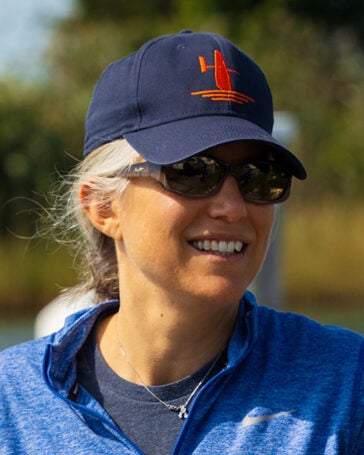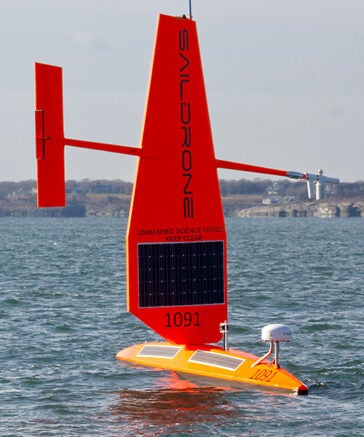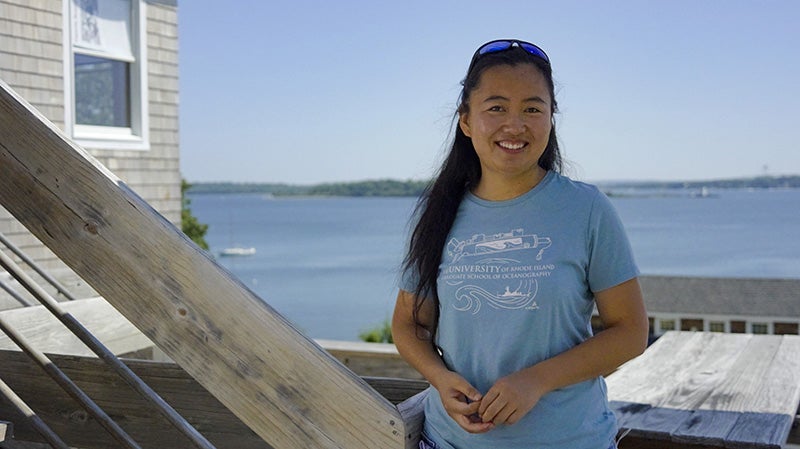By Ellen C. Liberman
Winnapaug Pond is the penultimate link in a necklace of coastal lagoons that lie behind the barrier beaches stretching from Narragansett to Westerly. Throughout the globe, these shallow transitional waters bear a heavy load as coastal flooding mitigators, shoreline stabilizers, and biodiverse habitats for plants, birds and marine and terrestrial organisms. Their productivity and calm beauty also draw fisherman, shellfish farmers, kayakers and home builders.
In the Narragansett language, “Winnapaug” means “a good pond,” and modern-day humans have certainly thought so. On the southside, it backs Misquamicut Beach, a developed waterfront on a popular summer attraction; houses line the east breachway; two golf courses abut its northern shore. Natural historians have identified Winnapaug Pond as the host of the rare diamondback terrapin and plant species such as Spring Ladies’-tresses. Government officials have sought to preserve it through dredging and eel grass restoration.
And now, Winnapaug Pond is on the threshold of playing another role: an incubator for a big idea to combat climate change.

In September, the National Oceanographic and Atmospheric Administration (NOAA) awarded GSO professor Jaime Palter and her six co-investigators $1,538,452 over three years to study if the practice of spreading lime over golf course greens adjacent to Winnapaug Pond allows the alkaline- enhanced waters to store more carbon without harming aquatic life. Her group was one of 17 representing 47 institutions to receive a portion of the $24.3 million competitive grant program, aimed at advancing research in marine carbon dioxide removal (MCDR).
In March, the Intergovernmental Panel on Climate Change issued its sixth assessment on state of global warming and current mitigation efforts, warning that to keep average temperatures from rising 1.5ºC above pre-industrial levels, greenhouse gas emissions must decline by 35% by 2035, on a pathway to nearly total emissions elimination by mid-century. Among the strategies to achieve this goal is carbon dioxide removal—to remove legacy emissions from the atmosphere, to counteract the warming effect of non-CO2 greenhouse gases, such as methane, and to offset the very hardest-to-abate emissions.
Enter the ocean. Its 352 quintillion gallons of water are the Earth’s largest net sink for anthropogenic CO2 emissions. The ocean had stored 50 times more carbon than the atmosphere, maintaining a balance with it for thousands of years. But, in the last two centuries, human activity has caused the ocean to absorb more CO2, boosting its acidity by 30% and threatening marine life. Could the ocean safely store more?
Millions in venture capital are already pouring into a variety of private sector proposals that range from using electricity to reduce acidity in ocean water, to pumping dissolved carbon dioxide underground to sequestering ocean carbon in seaweed.
“What’s the science on that?” asks Dwight Gledhill, acting director of NOAA’s Ocean Acidification Program, which studies the ocean’s complex carbon chemistry and its effects on marine organisms. “In the permitting process, federal agencies look at the body of knowledge to evaluate potential implications. Right now, that body of knowledge explicitly related to carbon dioxide removal impacts in the marine system is sparse, which is part of the reason we are trying to get a research program going. We are not entirely confident that some of the claims made by industry at this point are valid—they may be entirely valid —but they require careful assessment.”
Profiling Carbon Uptake
For more than a decade, Palter’s core research work has documented the ocean’s carbon cycle and its variability, with a focus on the shifting currents of the Gulf Stream and its myriad impacts—on the European climate, ocean oxygenation and increased heat in the northwest Atlantic, to name a few.
 Palter’s lab is now evaluating the data collected during one of her most “audacious” experiments–a study of ocean carbon uptake in the hotspot of the Gulf Stream. Palter partnered with Saildrone, a California-based company that designs, manufactures and operates wind- and solar-powered uncrewed surface vehicles to collect marine data in real time. In 2019, 2021 and 2022, multiple Saildrones sailed from Newport, R.I. out into the roughest Atlantic waters. They took atmospheric measurements and collected surface water trace data in three locations: off Cape Hatteras, by the New England Sea Mounts and off the Grand Banks of Newfoundland. The Saildrones regularly endured 25-foot seas—one was lost to a 40-foot rogue wave—while the others persisted for months.
Palter’s lab is now evaluating the data collected during one of her most “audacious” experiments–a study of ocean carbon uptake in the hotspot of the Gulf Stream. Palter partnered with Saildrone, a California-based company that designs, manufactures and operates wind- and solar-powered uncrewed surface vehicles to collect marine data in real time. In 2019, 2021 and 2022, multiple Saildrones sailed from Newport, R.I. out into the roughest Atlantic waters. They took atmospheric measurements and collected surface water trace data in three locations: off Cape Hatteras, by the New England Sea Mounts and off the Grand Banks of Newfoundland. The Saildrones regularly endured 25-foot seas—one was lost to a 40-foot rogue wave—while the others persisted for months.
“It’s a whole new age of exploration of the ocean carbon system.”
Ph.D. Candidate Sarah Nickford
This fall, Palter, Ph.D. candidate Sarah Nickford and postdoc Linquan Mu put the finishing touches on a manuscript about the utility of Saildrones for measuring ocean carbon uptake.
Nickford has plotted a map depicting the spatial distribution of carbon uptake in the Gulf Stream while showcasing the technological advances in oceanography.
“[It shows] all the carbon systems measurements ever made in this region in winter, and then overlaid the measurements we made in this single winter, and there are places where in 60 or 70 years of oceanographers doing this science, there is a single wintertime crossing of the Gulf Stream and we had these Saildrones crossing every week at three different positions. It’s a whole new age of exploration of the ocean carbon system.”
And they continue to work through the data.
“It’s complicated because the Saildrones are moving and the water is moving, so we have to find clever ways to process it,” Palter says. “Lin is using artificial intelligence to turn this wealth of data into fully resolved maps of the CO2 exchange in the Gulf Stream region that are going to teach us a lot. This will be a rich data set for many projects to come.”
From Pure Research to Researching Applications
In 2019, Palter’s thoughts began to turn toward applications. She had been serving on the Scientific Steering Committee of the Ocean Carbon and Biogeochemistry (OCB) program, an interdisciplinary network of oceanographers working to understand the ocean’s role in the global carbon cycle and the response of marine ecosystems to climate change.
“I thought: I am studying and describing these processes and a problem, but is there an application or solution in here?” Palter recalls. “Around the same time, I became aware that there was more and more attention on trying to engineer the ocean to take up more carbon.”
In September 2022, Palter and her colleagues hosted a workshop at URI for academics, government officials and commercial interests to discuss incentives for the OCB community to conduct research on measurement, reporting and verification of MCDR.
“Industries are seeing now that there are mechanisms like tax incentives that make it worthwhile,” says Gregory Frost, a NOAA Special Advisor for CDR. “For CDR to be viable there has to be a market, but for it to have any reliability we have to know that a technique does what it says it is going to do.”
In June, Palter and four co-authors published a letter in the scholarly journal EOS urging ocean scientists to step up to close this knowledge gap. Act quickly, they opined, before a nascent MCDR assessment industry places its imprimatur on scientifically unsupported claims of success made by companies trying to sell carbon credits.
This newest research project, funded by NOAA, demonstrates that commitment.
Evaluating This New Approach
“Adding limestone is a routine garden and agricultural practice, so adding alkalinity to the terrestrial environment is pretty well developed. Adding it to the ocean is less developed,” Palter says. “We are using the practice of liming for lawn care and the associated runoff as an analogue for intentional ocean alkalinity enhancement.”
The project at Winnapaug Pond will take advantage of a golf course’s annual spring liming to examine the effects of alkalinity enhancement along three tracks. The first involves water chemistry monitoring using sensors and several months of weekly sampling before and after application to measure the dissolved inorganic carbon, and the total alkalinity. The second will monitor shellfish in the lab and in the field to see what effect increased alkalinity might have on the grow-out rate and calcification of clams. Finally, the team will model to determine what happens to the alkalinity and dissolved inorganic carbon as it flushes out into the ocean, to estimate how much carbon dioxide might be removed, and if land-based liming could be scaled up along the East Coast.
The team includes GSO associate dean of academic and student affairs and associate marine research scientist Robert Pockalny, GSO professors Rebecca Robinson and Hongjie Wang, professor David Ho from the University of Hawai’i, EPA research scientist Jason Grear, and UConn marine science professor Samantha Siedlecki.
“It’s a big project for a small pond,” Palter says. “It’s so different from anything I’ve ever done and I can only do because of this tremendous team—no one of us has all the expertise.”
Mitigating Ocean Acidification
This latest experiment will extend Dr. Wang’s investigations into ocean acidification and hypoxia. Wang has documented low-dissolved oxygen and its frequent partner in warming waters, ocean acidification, in Texas coastal areas, the Gulf of Mexico and the Pacific Arctic Region
“The lab’s goal is to tell stakeholders what ocean acidification might look like in the summer or five years from now.”
Assistant Professor Hongjie Wang
“We studied the hypothesis that kelp could absorb the extra CO2 that is bad for oyster aquaculture,” she says. “It was very exciting—even if the impact was minor, the kelp did provide some benefit, from a water quality perspective.”

Her lab has also been combining observations of Narragansett Bay’s water chemistry, with the Regional Ocean Modeling System (ROMS)-Biogeochemical model, a widely used tool to study ocean and atmospheric dynamics and circulation patterns. Wang aims to develop ocean acidification forecasts that will reveal how acidification might change the bay in the present and in the coming decades. It promises real-world applications that could significantly impact Narragansett Bay’s aquaculture sector. The model can potentially identify areas in the bay most at risk of acidification, as a tool for those looking to site aquaculture projects. These “acidification hotspots” are zones where the water’s pH drops significantly, potentially harming marine life and affecting yields for fisheries and aquaculturists.
“My lab is working with other collaborators to add to the ocean acidification module to the available models. The goal is to tell stakeholders what ocean acidification might look like in the summer or five years from now—give you the trends and you can make necessary adaptation based on that.”
She has also used ROMS-biogeochemical modelling to explore potential methods to mitigate ocean acidification. In “Simulated Impact of Ocean Alkalinity Enhancement on Atmospheric CO2 Removal in the Bering Sea,” published in Earth’s Future, Wang and her co-authors simulated the climate mitigation impacts of adding alkalinity to the Unimak Pass in the Bering Sea. They found that adding the equivalent of 667,950 metric tons of sodium hydroxide allowed the cold surface water to begin to take up extra CO2 within 3.6 months, while increased alkalinity reduced the ocean acidification. While the results were promising, they also underscored the enormity of the challenge ahead. The simulation indicated that over 8,000 such alkalinity increments would be required to stabilize global temperatures by the end of the century.
“This is merely the beginning,” Wang said. “The model serves as an initial framework, giving us a glimpse into the potential outcomes of various climate mitigation strategies. It can guide us before we invest in extensive and costly observation networks.”
Wang will work on the ocean alkalinity enhancement project at Winnapaug Pond with Grear, a research ecologist at the EPA’s Atlantic Coastal Environmental Sciences Division. He has long measured the effects of nutrient pollution and coastal acidification on aquatic life in Narragansett Bay.
“We can’t study the whole ocean at once, so its good to have a small discrete study system that’s still connected to the ocean so we can get an understanding of circulation and mixing and how much of the added alkalinity stays within the pond and how much will move out into the ocean,” says Grear.
For Palter, the new research at Winnapaug Pond is exciting, but uncomfortable.
“No one wants to be manipulating the natural cycle, but that’s what humans have been doing—manipulating it on the largest scale and with great consequences. People are hoping to reverse it, but our techniques have to be safe and the benefits have to be real.”
